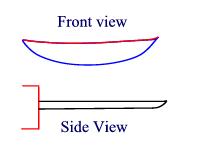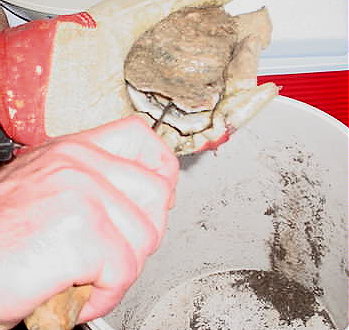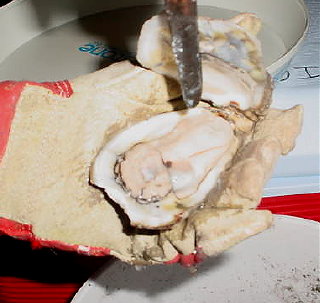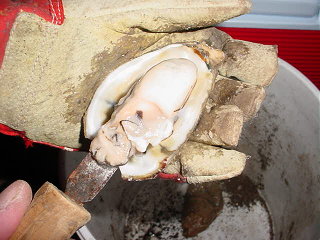
Shucking
oysters in South Louisiana is not uncommon, but, one old way of shucking
them is. My grandfather was an oyster shucker in New Orleans years ago
and back then he made his own knives similar to the one shown below. My
father made that one.
Today's popular shucking method is called prying or popping. The oyster
is opened from the back or hinge area. This is possible because today
the knife blades are made of really hard metals and can't be snapped in
two like the old blades. The old blades were thin and brittle and were
designed for cutting the knot of the oyster.

The
knife handle was formed to accommodate not only your hand, but fashioned
in a way that would allow the shucker to pick up a small hammer while
still holding the knife. Being able to shuck oysters in this manner sped
up the process. This was important because the shucker was paid on his
volume of oysters shucked.

The
knife blade was made in sort of a curve wherein the cutting edge was at
the top of the knife (shown in red on the "front view").

The
shucking process starts by creating an entry point for the knife tip
with the hammer.
Note: the hammer
shown here is bigger than the ones used, and, they had two square heads.
What is shown here is a regular ball pein hammer.
Notice I am holding the oyster knife while using the hammer. The square
head hammers' handle was a bit smaller and easier to handle.
What is being done in this picture is a few blows will be aimed at the
tip end of the oyster to allow access for the knife.

Next
the hammer is set aside and the knife is slid into the oyster with a
slight upward tip angle. Upon entry the objective is to cut the knot
away from the top shell. This is done in a sweeping motion and the knot
is cut easily because the cutting edge of the oyster knife is at the top
of the blade.
Once the knot is cut the oyster has no power to hold its shell tightly
closed.
The knife is then turned to the side as shown here to open it.

While
a firm hold is had on the bottom shell the knife tip is set on the
bottom shell away from the oyster then the top shell is pried up and
away. This is the only prying this knife will do and, since the shells
are easy to separate, no damage is done to the knife.

The
top shell is discarded and the knife now cuts the knot on the bottom
shell is sort of a scooping motion.

Finally
the oyster freed and ready to pop in your mouth.
The entire process is designed to maintain minimal knife-to-oyster
contact.
Now, if you use the prying method, you can still use the knot cutting
technique discussed here.

This
is the common prying knife discussed above and the kind most popular in
South Louisiana.
Here is another knife I found to work very well...
OXO Oyster Knife.
 The
knife blade was made in sort of a curve wherein the cutting edge was at
the top of the knife (shown in red on the "front view").
The
knife blade was made in sort of a curve wherein the cutting edge was at
the top of the knife (shown in red on the "front view"). This
is the common prying knife discussed above and the kind most popular in
South Louisiana.
This
is the common prying knife discussed above and the kind most popular in
South Louisiana.